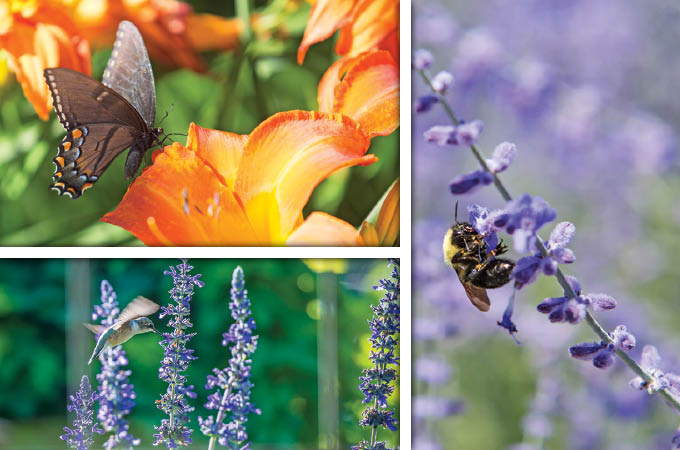Blooms are great for adding visual interest to a landscape and attracting those all-important pollinators. Another part of the allure of a flower garden is its wonderful fragrance! Here are some of our favorite fragrant plants for your outdoor spaces.
english lavender | This aromatic herb looks beautiful planted in a large swath in the garden, and it also grows well in containers. The dark, lavenderblue flower spikes are very attractive to butterflies as well. Lavender thrives in growing conditions similar to its native habitat along the Mediterranean coast. It prefers moist, cool winters and hot, dry summers. Well-drained soil and a full day’s sun are also essential for robust plants and plentiful blooms.
peonies | Prized for their form, stunning range of colors and exceptional hardiness, few other plants bloom so reliably year after year with such little care. Their large, glorious flowers add bright splashes of color to beds and borders, and their intoxicating fragrance makes them a wonderful cut flower. And, as a bonus, they are deer-resistant!
lemon balm | Part of the mint family, this herb has a lemon flavor and smells of lemon with a hint of mint. It’s great in teas and salads and perfect to use in bouquets. Lemon balm quickly can take over your garden if you’re not careful, so remove its flowers as soon as you notice them to prevent seeds from spreading.
catmint | At the peak of spring, the 30-inch plants are lush with a gray-green, scented foliage and covered in spires of soft purple blooms. If you struggle with growing the herb lavender, try Nepeta Six Hills Giant as an alternative. Catmint does best in full sun, planted in soil that is moist but well-drained.
lilac | This plant produces fragrant lavender blooms. Lilacs bloom best in full sun in well-drained, alkaline soil. Plants need a general fertilizer in early spring and after the bloom cycle. To encourage blooms, use a fertilizer high in phosphorus for your early spring feeding.
champneys’ pink cluster rose | You will find these throughout the rose garden at Moss Mountain Farm. It’s a Noisette, the first class of American roses. The clusters of pale pink blossoms have an intoxicating fragrance, and they can be trained to climb with the right support. Pruning will allow you to grow it as a shrub as well.oriental lilies | These fragrant flowers are late summer bloomers. They need to be planted in well-drained soil in full sun. Water moderately once they start to bloom. These lilies are easy to care for, but a word of warning: Deer will love your lilies as much as you do!
mock orange | Adding mock orange to the garden is one of my favorite ways to get a wonderful citrus fragrance without having to care for fruit trees, which can be a real hassle. While there actually is no color on the petals, the scent is really lovely. For best results, plant mock orange in full sun or partial shade and make sure the soil is moist and well-drained.
hyacinths | With a little love and patience, you’ll be rewarded with gorgeous, fragrant blooms in the spring. Many people grow them indoors by forcing the bulbs. To grow outdoors, plant the bulbs in early fall in rich, moist, well-drained soil. Growing hyacinths in containers is another option, and it gives you more control over soil conditions.
honeysuckle | You can’t go wrong with honeysuckle. It will thrive in most conditions and is a perfect choice for attracting wildlife to the garden. It grows best in full sun but can take a bit of shade. Plant in well-drained soil amended with organic matter for best results.
tuberose | With good drainage and ample mulching, these Mexican exotics are quite rewarding. They are prized for their tall sprays of pearly white, tubular, very fragrant flowers. Plant them near a patio, walkway, deck or other living space to enjoy the spicy-sweet fragrance. Grow tuberoses in organically rich, welldrained soil, and provide consistent moisture throughout the growing season.
wisteria | Oh, sweet wisteria! The gorgeous violet-blue blooms and their sweet smell that takes over the garden just scream spring. Wisteria is easy to grow but has be controlled with regular pruning. Plant in rich, moist soil in a sunny spot if you want blooms. Once established, wisteria is droughttolerant and requires very little care aside from pruning.
pineapple sage | A magnet for hummingbirds, butterflies and bees, pineapple sage is named for the pineapple scent of its foliage. The bold, red blooms make an appearance in late summer/early fall. Grow in a sunny spot that has a bit of afternoon shade. Soil should be well drained, but the plant needs moisture to support it as it grows quickly. Once established, it’s drought-tolerant.
trumpet vine/angel’s trumpet | Another plant that attracts hummingbirds, trumpet vine grows well in sun or partial shade and can handle most soil conditions. Trumpet vine is a rapid grower and, like wisteria, needs regular pruning. Consider a support structure like a fence or trellis.
gardenia | Very few plants can top the sweet smell of gardenias! The gorgeous white blooms pop against glossy, deep green foliage. Grow gardenias in a protected area that gets full sun to partial shade. The plant thrives in consistently moist, well-drained soil. Feed the plant in the spring with an all-purpose fertilizer before new growth starts.
P. Allen Smith is an author, conservationist and TV host of Garden Home on PBS and Garden Style (check your local listings). He uses his Arkansas home, Moss Mountain Farm, to promote the local-food movement, organic gardening and the preservation of heritage poultry. For tours of the farm, visit pallensmith.com/tours.
